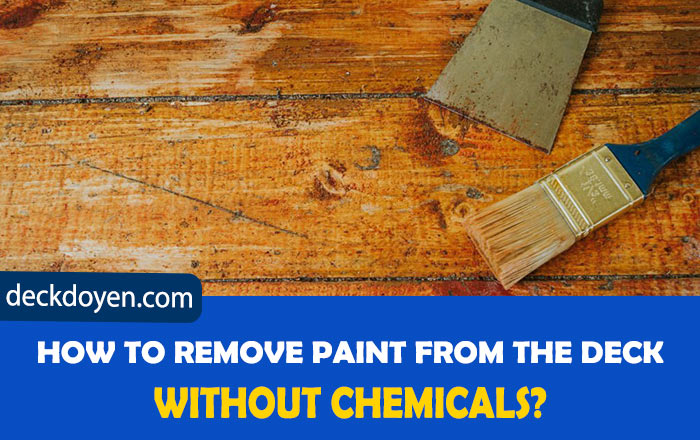Without a doubt, removing paint from the deck requires physically demanding work. But it would be highly helpful for us to use fewer chemicals because different chemicals can cause different allergies and can affect the life of the wood. Hence, you must be thinking of safe ways to remove paint from the deck without using chemicals.
The deck’s paint can be removed using either soy gel or citrus paint remover, both of which are safe for the environment. Traditional labor-intensive techniques, including the use of a heat gun, baking soda, sodium hydroxide method, wood sandpaper, and steam stripping, could also be used.
There’s more to it! Before you get set to work on removing paint from the deck, use chemical-free methods and products! Try to figure out the paint formula and the wood surface that you are working on!
To know why it matters? I have gathered all the necessary information so you can abide by the Federal paint laws and perform your task effectively!
Best Ways To Remove Paint From The Deck Without Chemicals
It can be a terrifying concept and a difficult task to successfully remove paint from the deck. When toxic chemicals are utilized, it may also be an extremely dangerous operation, needing everything from top-notch ventilation to pricey safety equipment to complete the task.
Good News is that there are countless ways to complete your task safely without the use of chemicals; let’s go through the basics, safety measures, and a few suggested practices for each one.
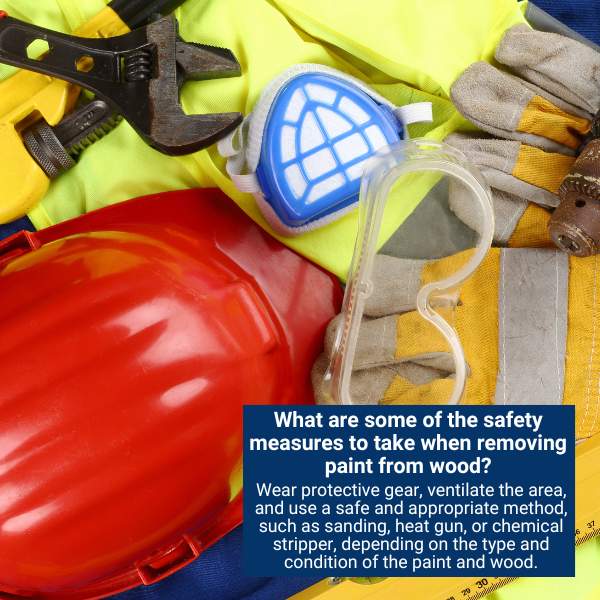
- Heat Gun Method: One of the non-chemical techniques for removing paint from the deck is the use of a heat gun. In comparison to a chemical paint stripper, it is faster and cleaner. Heat guns can still release harmful gases and damage your deck surface. Simply avoid heat guns alone, and always have a metal tray handy to store them on while not in use.
Put on the necessary protective equipment, eye protection, work boots, protective clothing, and a respirator mask specifically made for a hot air cannon in the meantime. Before beginning, you might also wish to place a fire extinguisher nearby.
- Switch on the heat gun and let it warm up. Keep the heat gun two inches away from the layer of paint when it’s ready. Usually, when heat is present, the deck and paint expand.
- Continue to work on the little area until the paint starts to bubble. To avoid the deck from burning or the paint from smoking, don’t work in the same spot for an extended period of time.
- To get as near to the bare deck as possible without really burning anything out, reheat numerous thick layers.
- Carefully scrape off the paint layers that have become loosened with a metal paint spatula or wire brush (in the case of lead paint). Don’t use too much pressure because this will scratch the wood.
- Use a narrower curved scraper if your deck has tight areas or narrow sections. To tackle tough spots and scrape off extra paint, repeat the previous steps.
- Take off all of the paint and use a soft cloth dipped in mineral spirits to wipe the surface.
- Sanding Method: When scraping paint from the deck on big, smooth surfaces, sanders (manual and powered) work well to protect your deck surface. When sanding, use safety goggles and masks.
- Before sanding, thoroughly clean the surface with a standard detergent and let it dry fully.
- Sand the entire surface with coarse 80-grit sandpaper, paying close attention to the direction of the wood grain. In order to avoid harming the deck, remove old paint with the least amount of force possible.
- Sand the entire surface once more with medium 150-grit sandpaper, then wash the dust off before starting the next step of sanding.
- Using fine 220-grit sandpaper, sand the whole surface. To get rid of leftover paint, add some elbow grease.
- To finish sanding the surface, remove the dust from it.
- Rinse the deck’s surface and clean it with a soft cloth dipped in water.
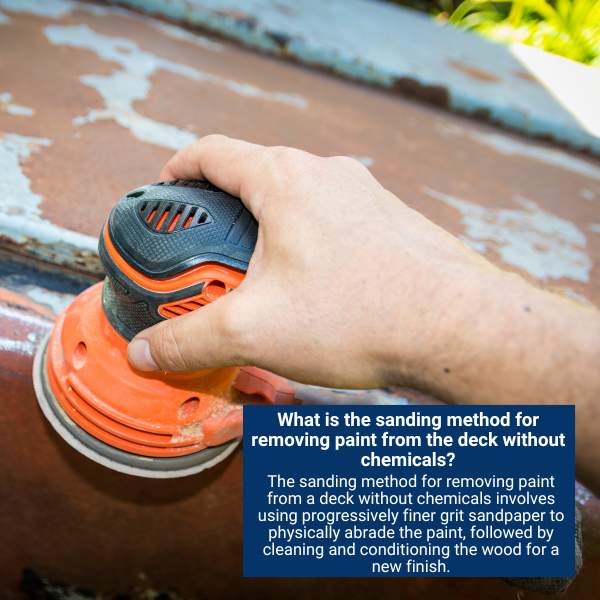
- Steam Stripping Method: Look not far further than steam strippers for a simple, non-messy method of chemical-free paint removal from the deck. For removing old paint from the deck, a steamer and a scraping blade are required. The scraper blades cannot be replaced once they are damaged, which is the only negative of this paint remover. In this situation, a putty knife will be useful.
Steamer Removal of Paint from the deck
- For about 15 seconds, keep the steamer an inch from the surface.
- As soon as the paint layer began to rise to the surface, scrape it off. A wire brush, putty knife, or scraper can all be used for this.
- To speed up the procedure, heat the next section.
- Sand the surface until it is smooth, and let it dry. You will need to wait a bit longer if the wood becomes dusty during the sanding process.
- Soy-Based Gel Paint Stripper: Methyl soyate and a methyl ester made from soybean oil are both ingredients in soy gel paint removers. Unlike petroleum-based solvents, this bio-based gel is environmentally safe and sustainable. It is not ozone-depleting and has low flammability. Additionally, this paint thinner has a low volatile organic compound content (VOCs). On wood, iron, and concrete, soy-based paint strippers can be used without risk.
However, it will take a bit more time before the paint becomes visible on the surface. Apply this product with a paintbrush to your workpiece, then let it sit for a few hours. It doesn’t evaporate, so you can apply it even longer. Furthermore, a longer-lasting soy gel boosts the effectiveness of the ultimate paint removal.
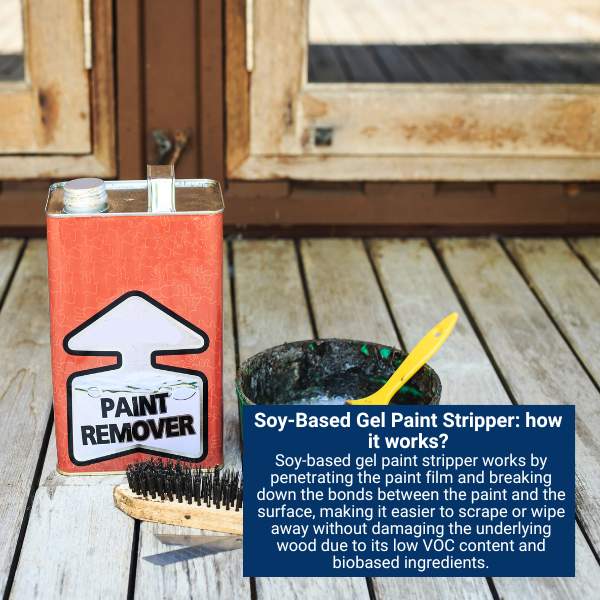
- Citrus-Based Paint Removers: Terpenes and plant-based organic chemicals, mainly from oranges, make up citrus-based paint removers. An outstanding example of a paint remover made from wood and resin is turpentine. Compared to chemical paint removers, these paint solvents take far longer to break down paint and have an orange-citrus aroma. This Citristrip is suitable to use on colored or varnished surfaces. Even if these paint removers are recyclable, you still need to properly dispose of the harmful substances they contain.
- Sodium Hydroxide Method: Since the invention of bread, sodium hydroxide has been employed as a paint remover. It’s one of the more traditional solutions for adhesive and difficult paint stains. To avoid serious drenches, it is best to use extreme caution when using sodium hydroxide to remove paint. It is essential to wear protective gear and operate outside whenever possible because of this.
To use, fill a container with two gallons of cold water, one cup of sodium hydroxide, and a second cup of corn flour. Then stir it thoroughly with a long wooden stick. The finished mixture can be applied to a hardwood surface immediately away, but for maximum efficiency, let it sit for about ten minutes.
- Scrapers Stripping Pads And Abrasive Blasting Method: One of the most difficult and time-consuming methods for removing paint off a wooden deck without chemicals is this one. However, it’s also the cheapest and has no chemicals. When the paint is in poor condition and cannot be repaired, a paint scraper is frequently utilized.
To ensure success, you should perform this procedure numerous times. The pads can be useful for a variety of tasks, including stripping wallpaper from walls without leaving unsightly stains. Additionally, there are a variety of options, some more affordable than others. Since they are constructed of abrasive fibers, using them indoors is safe. It is a great option for huge areas and is highly environmentally friendly.
- Opt For Pressure Washer:
Using a pressure washer to remove paint from a deck can be a useful method because it uses high-pressure water to blast away the paint, which can be less harsh and damaging to the wood compared to some chemical paint strippers. Additionally, it is an environmentally friendly option as it doesn’t require the use of chemicals.
To remove paint using a pressure washer, start by setting the pressure washer to the lowest setting and gradually increasing it as needed. Hold the pressure washer at a distance of about 6-8 inches from the surface and move it in a back-and-forth motion. After the paint has been loosened, use a scraper or putty knife to remove it. Repeat the process as necessary until all the paint has been removed.
It’s important to note that a pressure washer may not be effective for removing paint from all surfaces and in all cases and that the pressure washer must be adjusted appropriately for the specific surface and paint being removed to avoid damaging the decking.
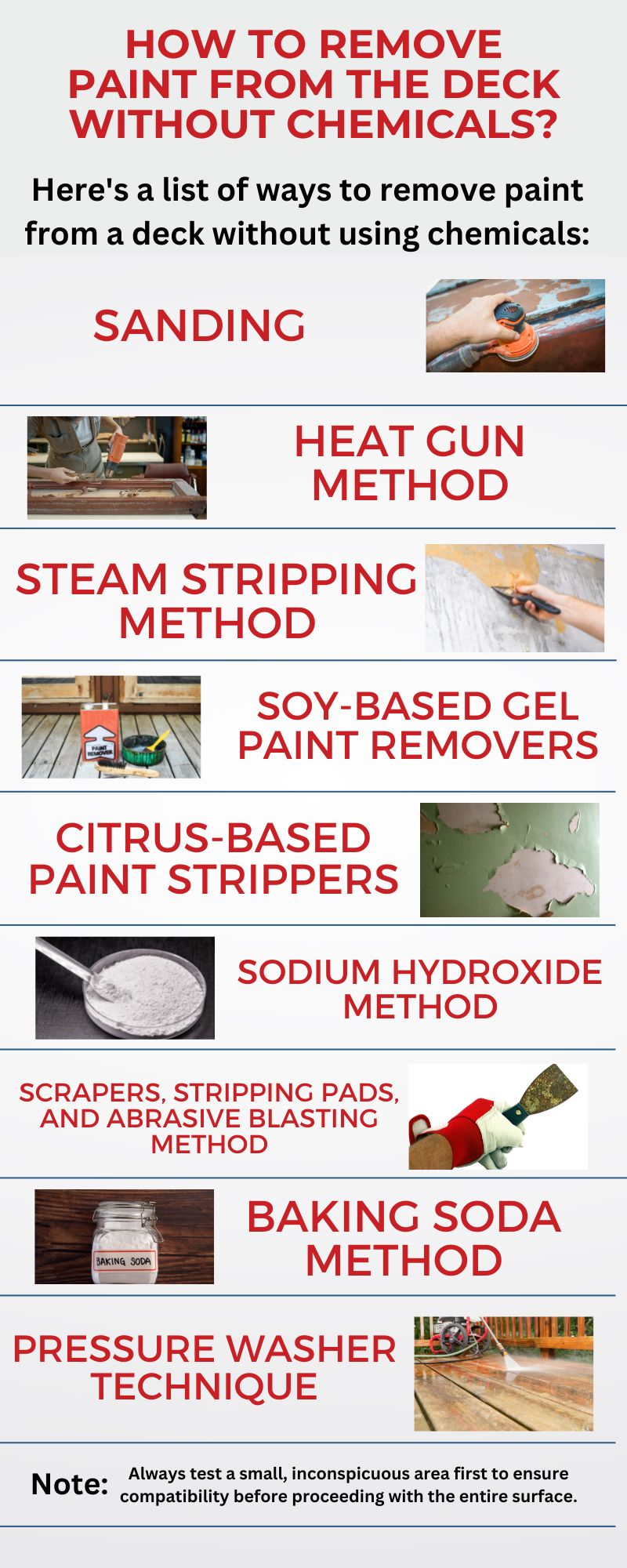
- Baking Soda Method: A mixture of boiling water and baking soda will assist in the quick removal of non-toxic paint. While this technique is mostly used to remove paint from hardware, such as door handles and hinges, it also works well to remove paint from wooden objects.
- Get a pot that is big enough to fit the wooden object inside. Fill the saucepan with water until it is one-fourth full. You’ll get better usage out of a pot that you are not really useful for cooking.
- Add a quarter cup of baking soda to the pot’s water. REMAIN STILL. Allow the solution to settle down.
- With the saucepan on the stove, turn it on. Make sure the water is simmering at a reasonable temperature that is neither too high nor too low. Set up a location to dry your wood piece as the mixture boils.
- Submerge the wooden object in the water. Apply the mixture to the painted portions if it is too large. Make sure the mixture has been applied to every area where you want to remove pain.
- Wait until the paint begins to bubble if you submerge the deck in the boiling fluid for around twenty minutes. The softened paint will then begin to peel off slowly.
- Apply the mixture gradually to painted surfaces of large wooden objects until the paint begins to bubble.
- Take the deck out of the boiling fluid and let it cool.
- Using a brush, remove the paint from the deck. When all paint debris has been eliminated, use a soft, dry towel to wipe the deck.
Conclusion
By using one of these methods, you can avoid exposure to dangerous chemicals and minimize the risk of property damage. In addition, many of these methods are also relatively easy to complete without any need for expensive safety equipment or ventilation.
All you will need is a few common home materials to work safely with those difficult paint and stains that don’t sound like fun.
I sincerely hope that this article has been useful in making removal simple and quick so that you can return to creating lovely DIY projects for your home.

